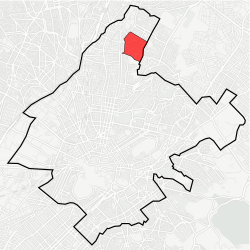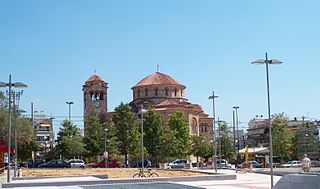
Aigaleo or Egaleo is a municipality in the western part of the Athens agglomeration, Greece. It takes its name from Mount Aigaleo. Its population was 69,946 at the 2011 census.

Galatsi, called in Katharevousa Galatsion, is a northern suburb of Athens, Greece, and a municipality of the Attica region. The municipality has an area of 4.026 km2. Until the mid-20th century, the area was mainly made up of farmlands but due to the continuous expansion of the Greek capital, Galatsi was rapidly urbanised and has come to lie in the center of the Athens agglomeration.

Monastiraki is a flea market neighborhood in the old town of Athens, Greece, and is one of the principal shopping districts in Athens. The area is home to clothing boutiques, souvenir shops, and specialty stores, and is a major tourist attraction in Athens and Attica for bargain shopping. The area is named after Monastiraki Square, which in turn is named for the Church of the Pantanassa that is located within the square. The main streets of this area are Pandrossou Street and Adrianou Street.

Koukaki is a southeast neighbourhood of the Municipality of Athens, Greece.

Thiseio or Thissio is the name of a traditional neighbourhood in downtown Athens, Greece, northwest of the Acropolis, 1.5 km southwest of downtown. Long ago, the name was derived from the Temple of Hephaestus which was mistakenly known as Thiseion in reference to Theseus, the mythical king of Athens, which gave rise to the neighbourhood being named Thiseio.

Akadimia, literally "Academy", is a neighborhood in central Athens, Greece.
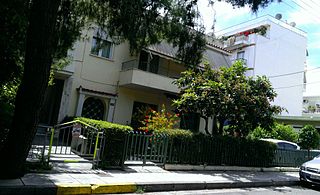
Ellinoroson, literally 'of the Greek-Russians', is a neighbourhood of Athens, Greece. As its name suggests, the area was first inhabited by Greeks fleeing from Russia.
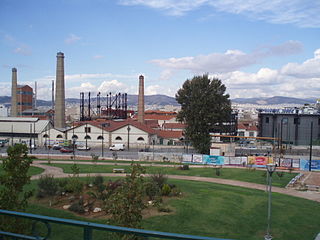
Gazi is a neighborhood of Athens, Greece. It surrounds the old Athens gasworks, which is the industrial museum and exhibition space "Technopolis", widely known as Gazi, next to Keramikos and close to the Acropolis.

Omonoia is a neighborhood in downtown Athens, Greece, centered on the square of the same name and served by the Omonoia station of the Athens Metro. Historically the heart of the city, it has experienced serious urban decay in recent years, becoming plagued by drug dealing, prostitution and theft, especially in its western part. Despite that, it is still a focal point for commercial and social life in Athens, especially for the various immigrant communities.

Petralona is a neighborhood of Athens, Greece. Athenians further subdivide the area into Ano (upper) Petralona or Kato (Lower) Petralona, where Ano Petralona is the area between the Philopappos Hill and the railway and Kato Petralona the area between the railway and Piraeus Street. Sometimes as part of Ano Petralona refers and the small neighbourhood Assyrmatos.

Sepolia is a neighborhood north of the centre of Athens, Greece. The Sepolia metro station is situated in the neighborhood. Sepolia owes to its name in the Greek phrase exo poleos, which means "outside the city". Sepolia was a remote settlement until the latter part of the 19th century, a few kilometres away from Athens. The Greek Census of that period didn't include Sepolia as part of Athens. The Census of 1879, for example, refers to a population of 278 inhabitants. During the following years, Sepolia joined Athens as a result of a population explosion.
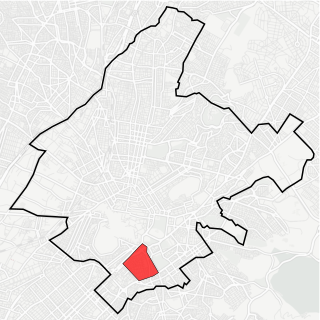
Kynosargous, formerly known as Dourgouti is a small neighborhood of Athens, Greece.

Aerides is a small neighborhood of Athens, Greece surrounding the Tower of the Winds, from where it takes its name. It is a subdivision of Plaka.

Agios Eleftherios is a neighborhood of Athens, Greece.

Probonas or Promponas is a northerly neighborhood of Athens, Greece.

Girokomeio or Girokomio, meaning 'nursing home' is a neighborhood of Athens, Greece.

Erythros Stavros, meaning "Red Cross", is a neighborhood of Athens, located between the districts of Ambelokipoi, Ellinoroson and Girokomeio. It was named after the Erythros Stavros Hospital, which is located in the center. It is also considered part of the Ambelokipi neighborhood. Apart from the hospital, this district is home to the Police School and the Ministry of Justice, Transparency and Human Rights. It is serviced by the Line 3 of Athens Metro and a plurality of bus lines.

Philopappou or Filopappou is a small neighborhood of Athens, Greece south of the Philopappos Monument, from which it takes its name.

Thymarakia is a neighborhood of Athens. It takes its name from the Greek word 'θυμάρι' which means 'thyme', which was formerly plentiful in the area.
